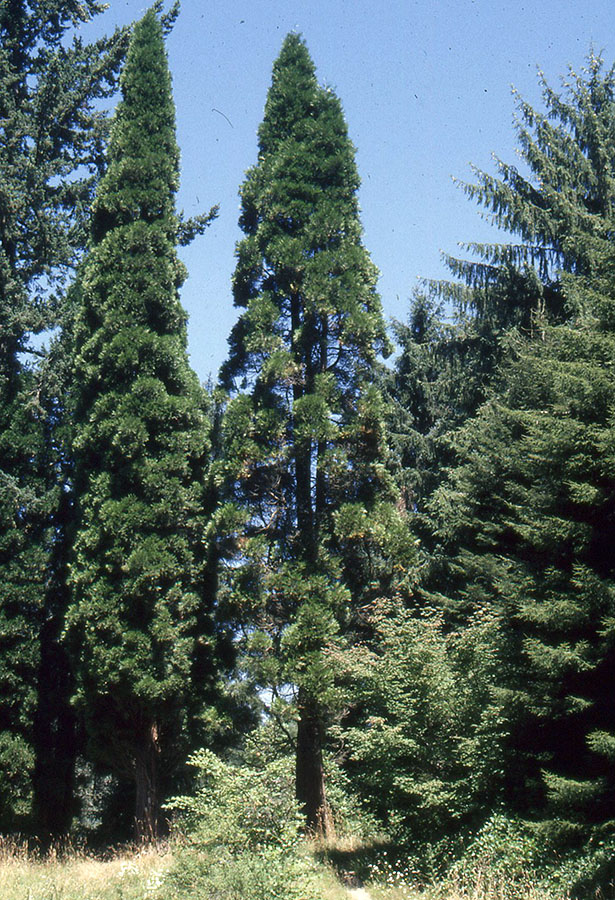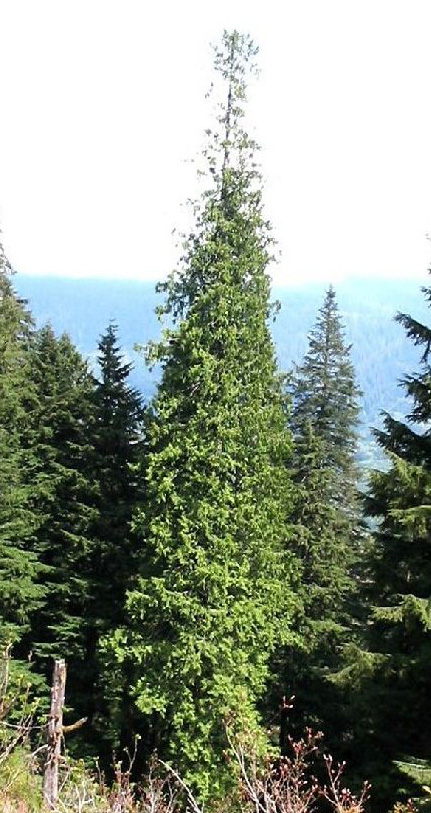Incense-cedar (Calocedrus decurrens) tolerates a variety of ecological conditions. Although it grows as a riparian (stream-side) tree or under other high moisture conditions, it is much more common in dry sites, where it is seldom a dominant species. Incense-cedar is especially drought tolerant; it can close its leaf pores (stomata) to prevent water loss. It was once the species of choice for wood pencils because of its straight grain and easy sharpening; most of the world's wooden pencils are now manufactured from tropical hardwoods.
The tree's former scientific name, Libocedrus decurrens, was changed based on anatomical studies of its cones. Its new name, Calocedrus, is based on the Greek for beautiful cedar. Libocedrus is still used for ten other species in the Southern Hemisphere. Libo refers to frankincense, an aromatic compound from a flowering tree that is not a conifer and is well known in Middle Eastern literature. Oregon's incense-cedar is the only North America Calocedrus.
Incense-cedar is a West Coast tree distributed in small populations on the east slopes of Mount Hood, south to the Santiam River. There it becomes increasingly common in the Cascade Mountains, south into the Siskiyou and Klamath mountains, and through the Sierra Nevada of California to Baja, Mexico.
The species grows in mixed conifer forests in the foothills and mid-elevation in Oregon. It tolerates some shade and can regenerate on mineral soil or relatively thick layers of litter and duff. Incense-cedar is found on a variety of substrates from serpentine to granitic soils. It is well adapted to the warm, dry summers and relatively wet, mild winters of southwest Oregon. Its thick fire-resistant bark allows older trees to tolerate surface fires. Large, old trees frequently bear fire scars with wood riddled with pocket dry rot caused by a pathogen that is not repelled by its aromatic wood. This result is what is commonly called pecker-wood.
The largest known incense-cedar, which grows in the Marble Mountain Wilderness in Northern California, is 469 inches in circumference and 165 feet high. The Oregon champion, in the Windy Creek drainage of the Rogue-Siskiyou National Forest, is 374 inches in circumference and 150 feet high. Just north of the California state line is the Tannen Lake Titan, with a circumference of 486 inches and rising 137 feet.
Native Americans used incense-cedar leaves in decoction for stomach trouble, as a vapor infusion for colds, and as a food spice. Other uses included bark fiber for basketry or twine and for friction fire-making and fuel. Branches were used for filters or brooms.
Incense-cedar is a fine-grained, easily worked, aromatic wood, generally resistant to decay (with the exception of pocket dry rot) and insects. It is used to make siding, window sashes, fencing, and interior paneling. The wood's insect-repelling aroma and workability make it a favorite for chests and closets to repel insects. Incense-cedar is grown as an ornamental tree in Europe and the eastern United States. It is a good tree for a green fence or wind break. It can stand summer heat, requires little water, tolerates poor soils, and no pruning is required.
-
![]()
Incense-cedar.
Courtesy Oregon State University -
![]()
Incense-cedar, foliage and cones.
Courtesy Wsiegmund, Wikimedia Commons
-
![]()
Incense-cedar, trunk.
Courtesy Oregon State University
Related Entries
-
![Port Orford Cedar]()
Port Orford Cedar
Port-Orford-cedar (Chamaecyparis lawsoniana)—also known as white or Ore…
-
![Western red cedar]()
Western red cedar
Western red cedar (Thuja plicata) is one of the grand trees that grows …
Related Historical Records
Map This on the Oregon History WayFinder
The Oregon History Wayfinder is an interactive map that identifies significant places, people, and events in Oregon history.
Further Reading
Eckenwalder, J. E. Conifers of the World: The Complete Reference. Portland, Ore.: Timber Press, 2009.
Jensen, E. C., and C. R. Ross. Trees to Know in Oregon (rev. ed.). Corvallis: Oregon State University Extension Service, 2005.
Moerman, D. E. Native American Ethnobotany. Portland, Ore.: Timber Press, 1998.
Van Pelt, R. Forest Giants of the Pacific Coast. Seattle: University of Washington Press, 2001.





